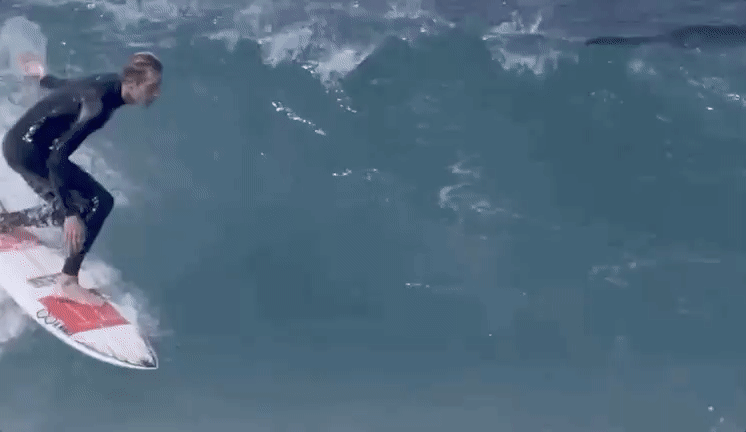Surfing and the problem with modern sports.
We still having fun?
Surf’s Up is one of my all-time favorite films. The mockumentary style animation starring the now canceled Shia Labeouf as a northern rockhopper penguin set on making it as a professional surfer is, unironically, a very good movie. Childlike gimmicks and aesthetics aside, the film posits a fun, succinct story about prioritizing what matters- fun and friendship come before ruthless competition.
At the time of release, parsing that message was easy enough. What wouldn’t dawn on me until I took to the waves was why the film chose surfing as the vehicle with which to ambulate such a message. Most films targeted at children, especially ones released by major studios, are imbued with the kind of unimpeachable morals that few would take issue with. Surf’s Up’s uncomplicated idea about fun and friendship is one that exists largely without opposition. But when examining the context in which that ostensibly elementary concept exists, it starts to get a little more complicated.
Surfing, unlike many sports, doesn’t have an immediately discernible path to success. Sure, you can stick your kid in some competitions and hope they do well enough to attract sponsors, but it’s far from a codified process of linear progression. Even with the proliferation of the World Surf League, modern surfing sits on an ever-widening fissure.
On one side, you’ll find a contingent of bright-eyed athletes whose salty, sun-kissed smiles do well to push sports drinks to unassuming admirers. On the other, a motley band of misfits that flick off waves as much as they do cameras. Both ends are sustained by differing ends of an advertising machine, each looking to speak to demographics that resonate with seemingly incongruous ideas.
But aside from a difference in Creatures of Leisure or Octopus stomp pads, either end of the chasm does represent an opposing perspective on the sport- consciously or not. Noa Deane’s infamous antics at the Surfer Poll film awards, where his inebriated alter ego gave the WSL a piece of his mind, perhaps best encapsulates the issue few are willing to actively speak on. In his apology, he maintained that while he did regret the vulgarity, his actions were propelled by a desire to express frustration with the systemization of his beloved craft. Deeming the rise of professionalism, ‘turning surfing into some football jock sport.’
Despite its mouthpiece being a heavily intoxicated twenty-year-old, the sport’s resistance to modernization isn’t new or out of place. Surfers have long since held issues with conformity, in part because rebellion is as natural to surfing as salt or suncream, but also because the synthesis with which most sports are currently undergoing disagrees with the nature of riding a wave for sport. Whereas something like football has an obvious winner or loser built into the conception of the game, it’s hard to see how someone can lose at surfing. Heck, if you’ve found yourself in the ocean on a day conducive to riding conditions- you’ve already won. You’re experiencing one of nature’s great pleasures and making the most of it on a plank of wood (or a mix of foam and fiberglass).
Jokes aside, that seems to be the crux of the argument for the contingent of people the community has lovingly deemed ‘free surfers.’ How professional surfing, or, better said, competitive professional surfing, systematizes performance for the sake of scoring and competition isn’t anything new -judged sports have existed for some time- it’s just at odds with the characteristics that have made the sport a cultural phenomenon.
Materially, surfing has largely resisted the tides of professionalization because it has a high barrier to entry. Take away new boards being $500 at a minimum, the geographical areas conducive to good surf are becoming increasingly rare. It’s no coincidence a large swathe of the world’s best surfers are people who grew up with at least some money on the islands of Hawaii.
With fewer people able to participate and the conditions that beset their participation often being less than ideal, surfing has long been subject to things far outside its control. Establishing leagues, clubs, TV rights, and all the other trappings of modern sport requires a certain degree of consistency. Only now, with the advent of something like wave pools and STAB high, a competition focused on aerial tricks, is some condition-based uniformity being presented for the sake of repeatability. Surfers, even ones who openly express their distaste for something like the professional qualifying series, are finding new and exciting ways to push the sport forward with ample opportunity to practice.
‘It’s a different sport than ocean surfing’- Dane Reynolds, STAB High 2018
That said, what’s often lost with the onset of systematization of any kind is exactly what free surfers are looking to avoid. While it’s a concept that seems to exist in phenomenological absentia, what it amounts to is a loss of personality. The characters people fall in love with, though often simulated at an individual level, are crowded out by the material realities of modern sport. People will likely always have unique and varied experiences on the road to being professionals, but that path becomes largely uniform when the preparation starts at five years old.
To draw an example from the most capitalized sport the world over, take any variety of Jezza or Bazza from the pre-Premier league era and their ability with a football was likely only part of the reason people liked them. They lived extravagant, exciting lives and often straddled the line between party and practice- sometimes blurring it. They didn’t all play for the same six teams and inevitably (and deservedly) cash in on their talent by being linked to the increasingly smaller contingent of clubs that dominate much of football’s material success. Romanticized and deeply problematic halcyon days of old they may be, the professional sporting sphere still partially represented an experience more akin to that of a few people on a Sunday afternoon. After all, that’s what sports are meant to be about. Fun.
For surfing, it’s hard to see how that kind of dynamic could ever truly set in. The material conditions that make the sport a reality are such that an absolute ‘jockification’ would succumb to the tides of change. Not to mention the appreciation for almost anyone putting a part together draws respect and admiration from kook and triple crown champ alike. Still, surfing’s battle with how the sport exists underlines a deeper point about the rest of our professional competitive experiences. Either side of the reductive perspectives I’ve drawn here may exist to sell us different ideas about what surfing is, but at least there’s still an element of authenticity. An almost senseless refusal to bow to one’s idea of progress or performance may seem childish and misplaced, but when it actively refutes some aspect of commercialization it’s something anyone can get behind.
The on-going pandemic has brought forth a number of revelations for almost everyone. Even now, as a group of manipulative financial analysts rails against being manipulated, people have been confronted with functions underpinning our modern state of being. Football, basketball, and several other sports have been jolted back into their cycles of perpetual motion for the sake of ‘necessity’ as TV contracts dared to go unfulfilled- leaving sticks of deodorant and shitty beer slightly less sold than at this point a year ago. If that’s what sports are about in today's day and age, it’s worth asking why we started doing any of this in the first place.
Amidst Surf’s Up’s ascending action, the film looks to mythologize one of surfing’s most distinct and iconic happenings. Using a slew of audio clips from professional surfers, the idealization of ‘the tube’ becomes the ligature between function and fun. Big Z and Co.’s description of the ecstasy of being tubed as sheer experience comes careening back down to earth when Cody asks how many points it would be worth.
While this oversimplification of what can be achieved on a board is exactly that, it still perfectly encapsulates the issue. Getting ‘tubed’ is a perfect storm of conditions, skill, and chance, all coming together to facilitate a truly awesome sight. For everything that must happen for rideable tubes to exist, then for a human on a board to possess enough strength, dexterity, and ability to perfectly balance themselves at the lip of a cresting wall of water is a good description of both why it’s amazing and worth quite a few points. Taming the water breathing hydra that results from a cosmic amount of energy being pushed across a planetary medium an ocean away is what makes surfing so truly incredible. The skillful aspects can understandably be taken, materialized, and packaged into codifiable metrics of performance, but it’s fair to say the awe of person and nature coming together in complete, liminal harmony- if but for a few seconds- gets lost within that process. Not every sport has that special unity with nature, but almost every one can at least pay homage to that feeling. However cliché or elementary a point that may seem, it’s one worth remembering.




